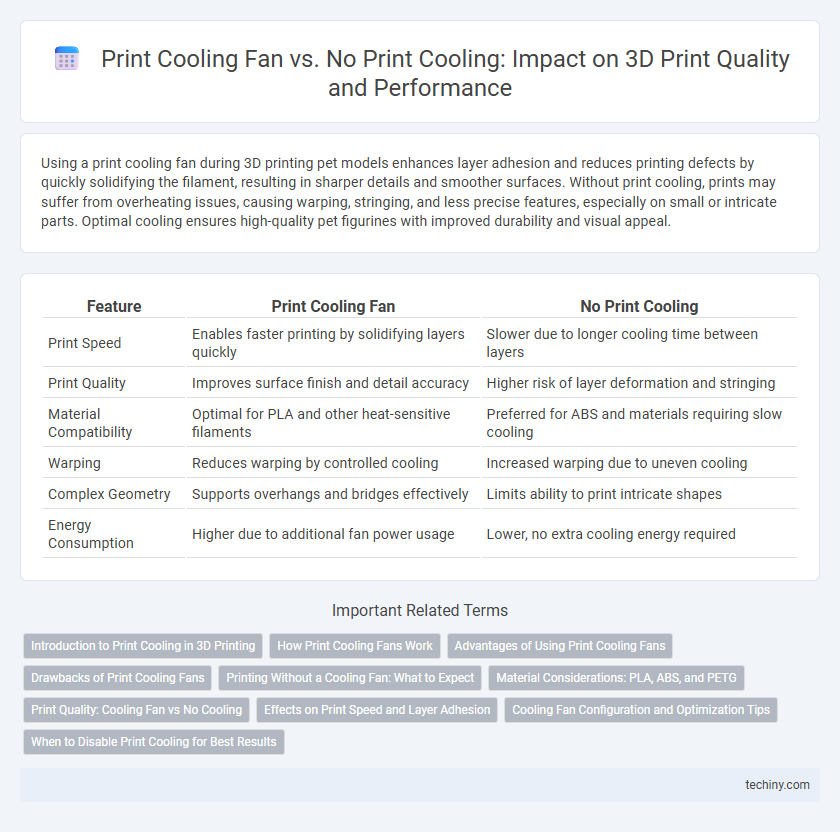Using a print cooling fan during 3D printing pet models enhances layer adhesion and reduces printing defects by quickly solidifying the filament, resulting in sharper details and smoother surfaces. Without print cooling, prints may suffer from overheating issues, causing warping, stringing, and less precise features, especially on small or intricate parts. Optimal cooling ensures high-quality pet figurines with improved durability and visual appeal.
Table of Comparison
| Feature | Print Cooling Fan | No Print Cooling |
|---|---|---|
| Print Speed | Enables faster printing by solidifying layers quickly | Slower due to longer cooling time between layers |
| Print Quality | Improves surface finish and detail accuracy | Higher risk of layer deformation and stringing |
| Material Compatibility | Optimal for PLA and other heat-sensitive filaments | Preferred for ABS and materials requiring slow cooling |
| Warping | Reduces warping by controlled cooling | Increased warping due to uneven cooling |
| Complex Geometry | Supports overhangs and bridges effectively | Limits ability to print intricate shapes |
| Energy Consumption | Higher due to additional fan power usage | Lower, no extra cooling energy required |
Introduction to Print Cooling in 3D Printing
Print cooling in 3D printing significantly impacts the quality and precision of finished models by controlling the solidification rate of extruded filament. A print cooling fan rapidly dissipates heat, reducing warping and stringing, which is essential for printing complex geometries and fine details with materials like PLA. Without print cooling, layers may remain too hot, causing deformation and poor layer adhesion, ultimately compromising print stability and surface finish.
How Print Cooling Fans Work
Print cooling fans accelerate the solidification process of molten filament by directing a focused stream of air onto the freshly extruded layers, enhancing print accuracy and surface quality. They regulate the temperature of the print, preventing warping and stringing by rapidly cooling complex geometries and overhangs. Without cooling fans, heat retention can cause material deformation and decreased detail resolution, especially when printing with PLA and other low-temperature filaments.
Advantages of Using Print Cooling Fans
Print cooling fans in 3D printing enhance layer adhesion and reduce stringing by rapidly solidifying the filament upon extrusion, resulting in sharper details and improved dimensional accuracy. Fans help prevent warping and overheating issues, especially when printing with PLA and other temperature-sensitive materials, by maintaining an optimal cooling rate. Using print cooling fans leads to higher-quality prints, smoother finishes, and fewer post-processing steps compared to printing without active cooling.
Drawbacks of Print Cooling Fans
Print cooling fans in 3D printing can cause issues such as warping and layer adhesion problems, particularly with materials like ABS that require slow cooling to prevent cracking. Excessive fan use may lead to uneven surface finishes and reduced interlayer bonding strength, compromising the overall durability of the printed object. Additionally, noisy operation and increased energy consumption are practical drawbacks that can impact the printing environment and efficiency.
Printing Without a Cooling Fan: What to Expect
Printing without a cooling fan can lead to issues such as poor layer adhesion, increased stringing, and longer cooling times, especially with materials like PLA that benefit from rapid solidification. Overheating of the print may cause warping or sagging on overhangs and bridges, reducing overall print quality and detail accuracy. Certain filaments like ABS or PETG may tolerate or even prefer slower cooling, but careful temperature and speed adjustments become critical to avoid defects.
Material Considerations: PLA, ABS, and PETG
Print cooling fans significantly improve PLA prints by reducing warping and enhancing surface quality through rapid solidification, while ABS benefits from minimal cooling to prevent cracking and maintain layer adhesion due to its higher thermal contraction. PETG requires moderate cooling to avoid stringing and ensure layer bonding without compromising strength, balancing between PLA's aggressive cooling needs and ABS's limited airflow tolerance. Proper adjustment of print cooling settings for each material optimizes print quality and mechanical properties in 3D printing.
Print Quality: Cooling Fan vs No Cooling
Using a print cooling fan in 3D printing significantly improves print quality by enhancing layer adhesion and reducing stringing and warping, especially with PLA and other thermoplastics. Without cooling, prints often suffer from overheating, leading to blobs, sagging, and less precise details, which negatively affects dimensional accuracy. Effective cooling controls the solidification process, resulting in sharper edges and smoother surface finishes.
Effects on Print Speed and Layer Adhesion
Using a print cooling fan in 3D printing enhances print speed by rapidly solidifying filament layers, allowing subsequent layers to be deposited sooner without deformation. However, excessive cooling can weaken layer adhesion, resulting in reduced structural integrity and potential print failures. Conversely, printing without a cooling fan improves layer bonding but often requires slower print speeds to prevent warping and ensure dimensional accuracy.
Cooling Fan Configuration and Optimization Tips
Optimizing print cooling fan configuration in 3D printing significantly enhances print quality by preventing warping and improving layer adhesion. Position fans to provide even airflow across the print surface and adjust fan speed dynamically based on material type and print complexity for best results. Using software-controlled fan profiles enables precise cooling management, reducing defects and enabling smoother, more detailed prints.
When to Disable Print Cooling for Best Results
Disabling the print cooling fan is essential when printing with materials like ABS or nylon, as it prevents warping and improves layer adhesion by maintaining higher bed temperatures. Slow print speeds and thick layers also benefit from reduced cooling to ensure better bonding between layers. Avoiding print cooling in these scenarios results in stronger, more durable prints while minimizing issues such as cracking or delamination.
Print Cooling Fan vs No Print Cooling Infographic

 techiny.com
techiny.com